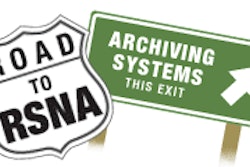VIENNA - My great uncle Mansel traveled the breadth of Russia, from Moscow to Vladivostok, shortly after the turn of the last century. I asked him what the most significant thing was that he'd learned during his six-month journey nearly a hundred years ago.
"It's a really big country -- really big," he wryly replied.
Today, the Russian Federation is still a large territory; it comprises 11 time zones with an unevenly distributed communications and IT infrastructure, population, and medical services. These were the challenges facing a Russian Federation team that set out to create a nationwide teleradiology service.
"The main task of any teleradiology project is to provide remote and instantaneous access to the imaging data, in the most diagnostically correct format," the authors wrote in an electronic presentation online system (EPOS) poster distributed at the European Congress of Radiology (ECR). "The quality of the service should not be affected by particular user location, software, or hardware."
The team examined other teleradiology projects and services in order to learn from past mistakes and to craft a set of achievable design goals.
"In brief, many teleradiology projects aggravate the limitations of old and local PACS architecture with the deficiencies of limited Web-based interfaces," they wote. "This, as well as any loss in quality or performance, is not acceptable for radiology in general and teleradiology in particular."
The group reported that it came up with six fundamental and achievable design goals for its project:
- Universal access to the teleradiology network, particularly for mobile users who log in from multiple locations on a variety of platform architectures
- DICOM used as the main image format
- The capability to interface directly with any PACS with no human interaction and no data reformatting
- Image compression that was as independent as possible of network bandwidth
- Contemporary security throughout the network
- Sufficient image display and processing functions
"With these settings, a remote teleradiology expert should be able to walk into any Internet café or a friend's house with dial-up Internet access, and still be able to do his work," the team wrote.
In 2004, the group initiated the project at the department of tomography at the Russian Cardiology Research Center in Moscow, with the support of the Russian Foundation for Basic Research. First, the group ensured that all modalities in the facility were DICOM 3.0 compliant, linked its PACS network to the Web through a secure teleradiology server, outfitted the PACS with DICOM gateway technology, and implemented high-quality medical image compression and security applications.
Most importantly, the team lined up expert radiologists who were willing to participate in the project and provide image interpretation.
"Teleradiology design should be driven by the actual project participants and physicians," the authors noted.
In 2005, the team gradually began a nationwide extension of the network across the Russian Federation with some enhancements to the original configuration. These included the following:
- A Java-based online image viewing application able to accommodate virtually any client configuration
- Images upload functionality, including batch file and online report capabilities
- Automatic image compression based on network speeds
- Memory management tools for large study viewing
- An online tutorial
The first test of the system occurred at the RSNA conference in Chicago, when a Moscow-based radiologist accessed the servers to read his patient's images on a laptop connected through a wireless hotspot at the meeting. The success of this ad-hoc test led to the expansion of the network throughout Moscow, then across other regions in the federation.
The system met all the original design criteria and more, according to the team. They reported that a radiologist successfully accessed and utilized the teleradiology service for a diagnostic read at an Internet kiosk located in an airport lounge.
The flexible and robust architecture of the software has proved so fundamentally sound that it was recently deployed to help recover radiology networks in Louisiana after Hurricane Katrina.
"As our experience demonstrates, building a nationwide network is a very feasible task, provided you plan for the most diagnostically sound and technically optimized solution," the authors wrote.
For further information on the project and its design, the group maintains a public international teleradiology gateway at www.itelerad.com; its Russian Federation teleradiology Web site may be accessed at www.tomography.ru/teleradiology.
By Jonathan S. Batchelor
AuntMinnie.com staff writer
March 6, 2006
Related Reading
Homegrown tool improves radiologists' workflow, December 16, 2005
Cuba's IMAGIS brings PACS power to the people, September 29, 2005
Lossy compression wins over Canadian radiologists, July 21, 2005
Web-based workflow and reporting systems keep imaging on track, March 10, 2005
ACR international teleradiology task force releases white paper, February 15, 2005
Copyright © 2006 AuntMinnie.com



















